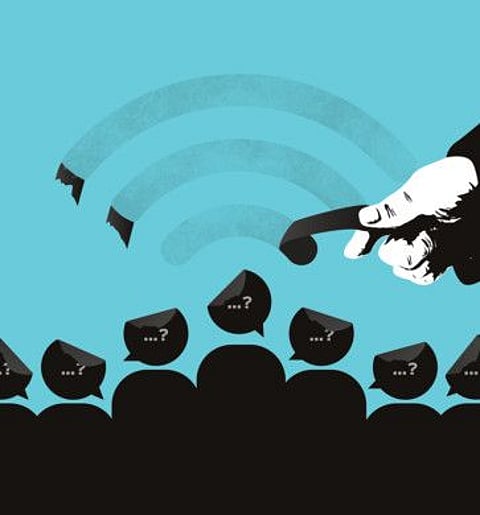How the regime cut off all Iranians
Fearing more public protests, authorities in Tehran have suspended internet services

The unrest in Iran has become so intense that the authorities have cut off the entire country from the internet. That’s made it much more difficult for Iranians to communicate with the outside world — and vice versa.
Group conversations on WhatsApp, Telegram and other messaging apps are frozen in time. Foreign emails sent to friends inside the country go undelivered. Iranian Instagram — a vital domain for the self-expression of ordinary Iranians — has no new images.
And tweets in Persian that claim to originate from Iran are being sent either from fake accounts and bots outside the country or from the small number of people who still have access to the internet (among them, Supreme Leader Ayatollah Ali Khamenei).
It turns out there is very little the outside world can do to remedy these matters.
Policymakers and activists in the West have long been discussing how to overcome the technical obstacles to the spread of information in Iran. How can we bring freer access to a country whose telecommunication authorities block access to websites and routinely disrupt service during moments of unrest?
At the same time, though, some of the sanctions policies were pushing in the opposite direction. By prohibiting Iranians from accessing the global financial system, we also cut them off from e-commerce platforms. Nor, for similar reasons, are they able to use cloud services.
Today, though, all the government has to do is push the “off” switch between the NIN and the networks of the outside world. Just for good measure, the regime also shut down most of the NIN itself, thus hampering Iranians’ ability to communicate with each other.Jason Rezaian
The Iranian authorities responded by developing their own domestic internet (known as the National Information Network). The NIN has, among other things, become the gateway through which Iranians access global networks.
In 2009, when Iranians took to the streets to protest the contested reelection of the then President Mahmoud Ahmadinejad, cutting off the internet would have entailed cutting off millions of telephone lines. The authorities did manage to slow access times, which was in itself incredibly disruptive. But access to the global internet wasn’t completely severed as it is now.
Pushing the ‘off’ switch
Today, though, all the government has to do is push the “off” switch between the NIN and the networks of the outside world. Just for good measure, the regime also shut down most of the NIN itself, thus hampering Iranians’ ability to communicate with each other.
“Unfortunately, there’s no immediate solution besides politically pressurising Iran’s government to restore access. “We have to learn from mistakes and find a long-term solution,” Amir Rashidi, the internet security and digital rights researcher at the Centre for Human Rights in Iran, told me. In recent years, the government of the United States has spent millions of taxpayer dollars on internet freedom initiatives.
Last week, Brian Hook, the US special representative for Iran, said his team was looking into ways “to help the people work around the Iranian regime shutting down the internet”.
The Iranian government has specifically developed its current infrastructure to minimise interference from the outside world. Needless to say, that’s not the fault of the West. The western world could have expected Tehran to take its technological evolution in this direction anyway, but the West’s policies certainly haven’t helped.
Early in his term, Iranian President Hassan Rouhani ended the telecommunications monopoly and licensed several domestic companies to develop and provide 3G and 4G services to work on the NIN. The domestic internet soon provided faster and more reliable service, something most people supported. Few of them noticed the catch — that they could access the global Web only through the new domestic network. Now, that weakness has become manifest.
Rouhani is one of the people most responsible for this suppression. This internet blackout is unprecedented, it’s suffocating. “The system wants to silence everyone. Inside, outside, journalists, politicians, world leaders, other countries, an Iranian source revealed.
There is no law, after all — domestic or international — obliging Iran’s government to provide unfettered internet access to the country’s population.
If the US wants to help it needs to understand the consequences of its technological sanctions on Iran. “They need someone who knows Iran, and I don’t see anyone like that in the current administration,” Rashidi notes.
Rather than issuing statements about helping Iranians share videos of protests, the US must develop ways to get them back online and keep them there.
In addition to removing restrictions that block Iranians from using common personal and business online services, this would include providing international cloud services and infrastructure.
Otherwise, they’ll remain as defenceless as they are right now.
— Washington Post
Jason Rezaian is a prominent columnist who specialises in Middle East affairs.
Sign up for the Daily Briefing
Get the latest news and updates straight to your inbox



